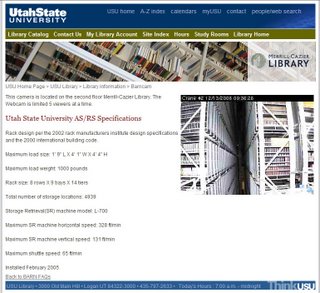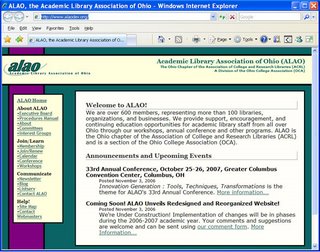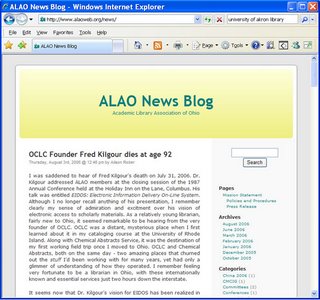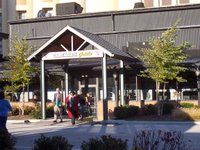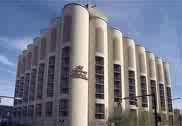I’m sure Diane is busily writing her own conference report as I speak and I look forward to reading her take on some of things at the conference. As far as I remember, we were only in one session together, so I’m interested in hearing about some of the sessions that I didn’t attend. So here’s my take on the 32nd annual ALAO Conference.
Business MeetingSince it was my first conference and I just joined ALAO about a month ago, I was actually interested in hearing the things from the business meeting. I found it refreshing that the Vice-President/President-Elect Doug Morrison asked for suggestions for speakers for next year’s conference and was glad to hear that it will be a two-day event in Columbus.
President Ann Watson said that the website was being redesigned and introduced the webmaster to show off the new design. If you want to see what it looks like you can see it
here, just keep in mind that this new site design is still in development; you should still use the
ALAO website for your information needs, the new design will take over that address in due time. I’ve looked at the new design, and I have to say that I look forward to its implementation as soon as it’s ready; it’s a great improvement.
Keynote SpeakerSince this was my first conference, it was also my first keynote address at a conference. I think future keynote speakers have a lot to live up to. Dr. J. Richard Madaus, the Executive Director of the
College Center for Library Automation in Florida, had the audience in the palm of his hand from beginning to end. I was no exception. Anyone who begins a speech with a quote from
Albus Dumbledore has my undivided attention no matter what he’s talking about, but the subject matter was just as impressive as the speaker. While I can’t possibly summarize an entire hour’s speech in a paragraph or two, I’ll try and give you the basic highlights and you can view his presentation if and when it is up on the ALAO website.
Dr. Madaus said there are 3 main areas of information: print, proprietary electronic, & the free web. But how much time and money are spent on the free web? He spent a lot of time making the point that although the free web makes up easily the largest way people seek information, we are not adequately addressing it as an area where we can play a role. This is also true when it comes to “gizmos.” Many undergrads today utilize their cell phones and PDAs to view documents and search the web, but how compatible are our web pages with those items? Our patrons use tagging, blogging, wikis, podcasts, & RSS, but how much are we using it? Although he didn’t ask it, his speech raised in my mind the question: How compatible are librarians and libraries with the patrons we are trying to serve? The answer I came up with is: not very compatible at all at this point.
The best point that I felt Dr. Madaus made is this (I think I got it as a direct quote), “It’s not about technology; it’s about people and the way they live.” He’s right. So often, we as librarians make excuses for being behind and blame technology for a lack of use in more “traditional” library services. The gutsiest thing that Dr. Madaus asked, in response to the inevitable money question with technology is “what can you stop doing?” We need to have a stop list of more “traditional” things that are not reaching our patrons so that we can start services that will reach them. There is a critical need to move past a place-bound librarianship. He made the observation that getting our patrons to our website is often as hard as getting them into the building because the website is just another place. New strategies are needed, and new global perspectives are required in order to keep up with changes in technology and the way people seek information.
This was a phenomenal speech and was definitely an eye-opener to many people in the room who hadn’t heard of many of the developments that are going on. He really emphasized the fact that many changes needed to be made yesterday and we’re already behind on changes that need to be made for tomorrow.
Stay tuned for Part Two of this report on Tuesday, November 7th.
Tags: ALAO, library conference, ALAO conference, academic librarians


